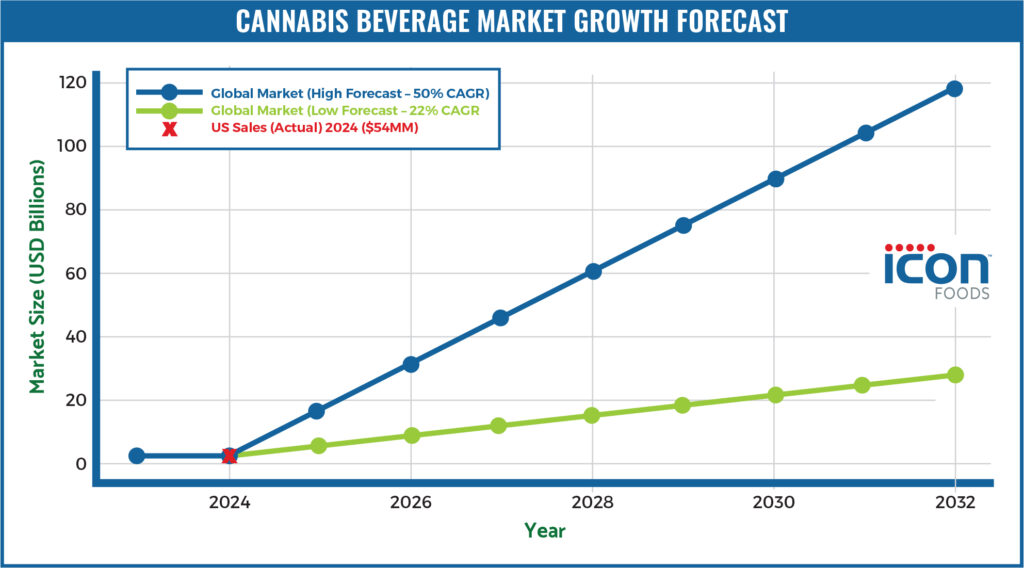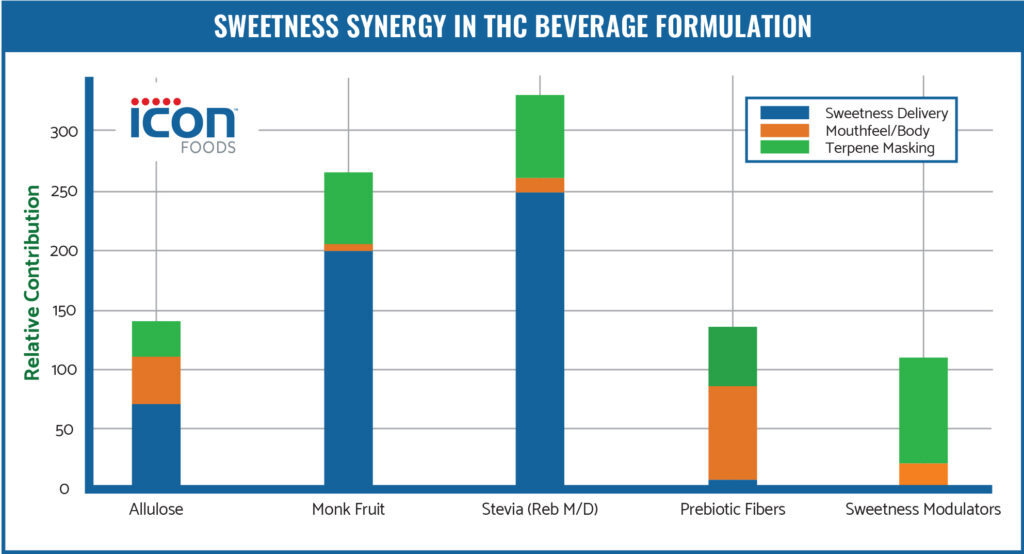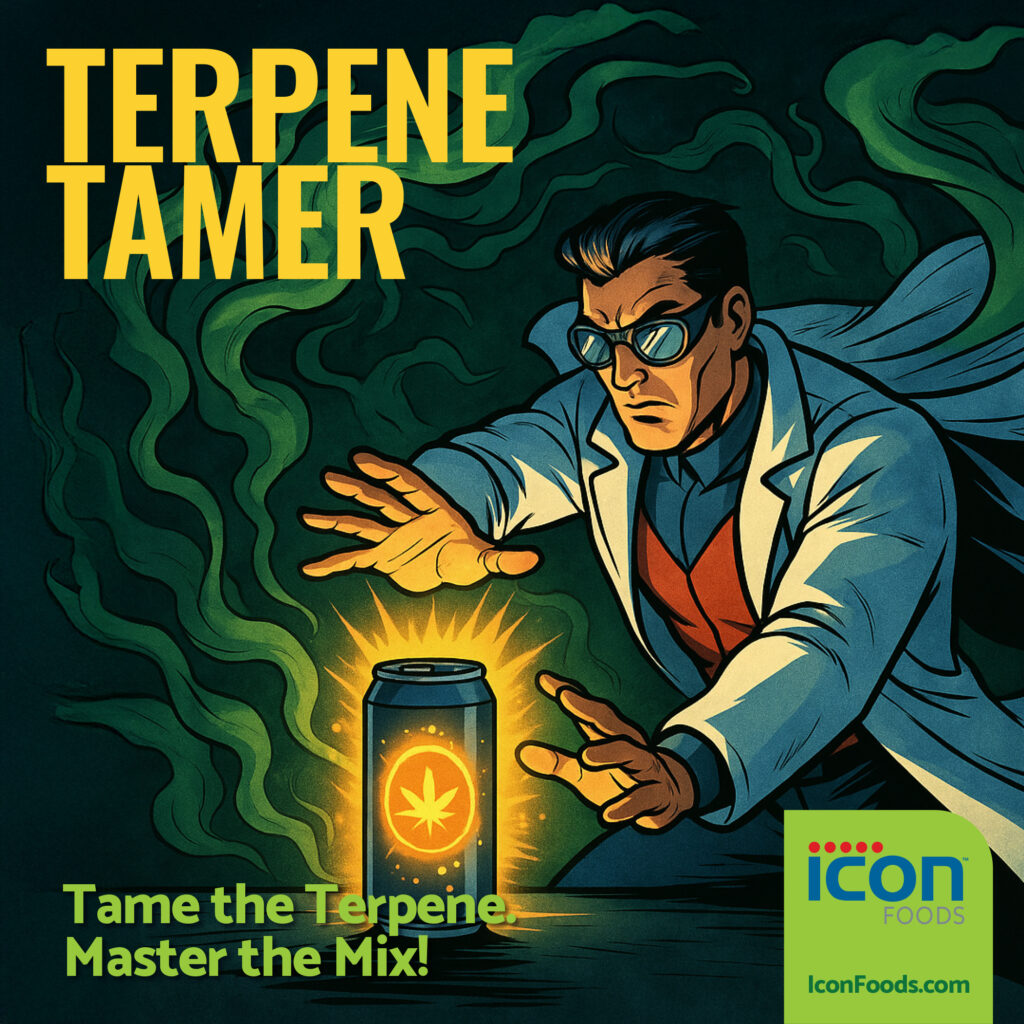Cracking the Code on Mouthfeel, Sweetness, and Terpene Oddities
Summary
As alcohol consumption declines and health-conscious consumers embrace cannabis beverages, formulators face a new challenge: creating low-sugar THC drinks that taste great without the “weed tea” effect. This white paper explores how clean-label sweeteners like allulose, monk fruit, and advanced stevia glycosides, combined with prebiotic fibers and natural flavor modulators, can replace sugar’s critical role in sweetness, mouthfeel, and balance. By strategically layering sweetness and masking terpene bitterness, brands can craft THC beverages that deliver indulgent taste, smooth texture, and wellness appeal—all while maintaining clean-label credibility. In the fast-growing cannabis beverage market, mastering sugar reduction isn’t just innovation—it’s competitive advantage.
Authored by: Thom King, Icon Foods
Chief Innovations Officer/Certified Food Scientist
For years, alcohol held court as the default for social sipping. But today, that reign is crumbling — especially among Millennials and Gen Z. Gallup’s 2025 data shows just 54% of U.S. adults now drink alcohol, the lowest rate since tracking began in 1939, and only half of young adults (18–34) are imbibing, down from nearly 60 % in 2023. Two-thirds of that same cohort now believe even moderate drinking is harmful, up sharply from past years. Gen Zer’s are drinking about 20% less per capita than Millennials; nearly one in three of them has never had a drink at all. This isn’t just a passing phase — it’s a generational shift, fueled by health-first values, wellness culture, and a growing disinterest in alcohol’s empty calories and hangovers.
Meanwhile, the THC beverage world is erupting into that vacuum. Forecasts suggest the global cannabis beverage market could grow from roughly USD 2 billion in 2023 to between USD 28 billion and USD 117 billion by the early 2030s, depending on the report, with compound annual growth rates ranging from 22% to over 50%. In the U.S. alone, cannabis beverage sales hit an estimated USD 54 million by mid-2024, climbing more than 11% year-over-year. Drivers? Millennials and Gen Z are crushing it here, seeking functional, low-sugar, wellness-aligned alternatives that deliver sociability without the booze. THC beverages offer that “social lift” without guilt, modern formats, precise dosing, clean-label positioning, and fewer calories. It’s more than a product pivot. It’s the future of social sipping.

Above is a Cannabis Beverage Market Growth Forecast graph that shows:
- Global Market (Low Forecast ~22% CAGR): Climbing from $2B in 2023 to ~$28B by 2032.
- Global Market (High Forecast ~50% CAGR): Shooting from $2B in 2023 to ~$117B by 2032.
- U.S. Market Snapshot: $54M in sales by mid-2024 (plotted in red), already growing at an 11%+ clip year over year.
If you’re formulating THC beverages, you already know you’re walking a tightrope. On one side, you’ve got regulatory pressures and clean-label demands. On the other side, consumers who expect their cannabis beverages to taste as indulgent and satisfying as a craft soda or hard seltzer. And let’s not sugarcoat it (pun intended): THC drinks come with baggage; namely the herbal, resinous, sometimes “backyard weed” notes from terpenes and cannabinoids. Couple that with the need to reduce sugar without sacrificing sweetness or mouthfeel, and you’ve got yourself one of the trickiest formulation puzzles in the better-for-you beverage world.
But here’s the good news: we can solve it. With the right stack of clean-label sweeteners, prebiotic fibers, and natural modulators, you can create THC beverages that sip smooth, hide the terpene funk, and still meet sugar reduction targets. Let’s dig in.
The Sugar Problem in THC Beverages
Sugar reduction isn’t just about calories anymore, but it’s a positioning strategy. Consumers in the cannabis beverage category overlap heavily with wellness-focused consumers. They’re already reading labels, counting grams of sugar, and scanning for “no artificial sweeteners.” Add in the fact that many are using THC as part of a broader lifestyle shift (stress reduction, sleep support, alcohol replacement), and suddenly, a 20-gram sugar bomb doesn’t make sense.
The challenge? Sugar isn’t just about sweetness. It’s the backbone of mouthfeel, body, and balance in beverages. Take it away, and THC’s earthy terpene profile becomes the loudest voice in the room.
Clean Label Sweetening Strategies
Allulose + Monk Fruit
- Allulose brings bulk and body, while monk fruit adds the high-intensity sweetness lift. This combo mimics sucrose’s onset and decay curve without the bitter, metallic aftertastes that consumers associate with older generations of stevia. Perfect for keeping the taste buds busy while masking terpene edges.
Stevia (the Right Glycosides)
- Forget the old Reb A days. Modern stevia glycosides like Reb M and Reb D deliver clean, sugar-like sweetness with minimal aftertaste. Blending them with monk fruit helps bury residual terpene notes while rounding out the sweetness curve.
Sweetness & Flavor Modulators
Think thaumatin, natural flavor maskers, and receptor modulators. These don’t just sweeten—they shift how the brain perceives bitterness and “green” notes. In THC beverages, they’re like the bouncer at the terpene nightclub, keeping the funk contained.
Below is the Sweetness Synergy Chart showing how allulose, monk fruit, stevia, prebiotic fibers, and sweetness modulators stack up for sweetness delivery, mouthfeel/body, and terpene masking in THC beverages.

Burying the Terpene Notes
Let’s face it: terpenes are polarizing. While some consumers celebrate them, most don’t want their drink to taste like they just chewed a pinecone. The trick is to layer sweetness with modulators and fibers, so the terpene notes are muted but not erased. The cannabis “whisper” should still be there—it just shouldn’t dominate the conversation.
- ThauSweet DRM (Thaumatin + Reb M): Covers high notes and lingers long enough to hide bitterness.
- Allulose + Fiber: Builds a mid-palate cushion that softens resinous edges.
- Natural Flavors (Citrus, Berry, Tropical): Strategically layered flavors can synergize with terpenes instead of fighting them, creating a more “crafted” experience.
Here’s the kicker: formulators who can deliver low-sugar, full-bodied THC beverages that don’t taste like weed tea will own the next phase of this category. Clean-label claims (“no artificial sweeteners,” “plant-based,” “with prebiotic fiber”) add marketing fuel. Sugar reduction is no longer a cost-saving measure, but it’s a differentiation strategy.
At the end of the day, the winners in THC beverages will be the brands that get the taste right. Cannabis consumers may forgive a slow onset or a slightly higher price tag, but they won’t forgive a drink that tastes like bong water.
Sugar reduction done wrong highlights everything consumers don’t want. Sugar reduction done right, through strategic blends of monk fruit, stevia glycosides, allulose, prebiotic fibers, and flavor modulators, delivers clean sweetness, satisfying mouthfeel, and just enough terpene nuance to remind the consumer why they reached for a THC beverage in the first place.
Formulation is about balance, and in THC beverages, balance means keeping sweetness, mouthfeel, and cannabis character all in harmony. Do that, and your brand isn’t just surviving in this category, it’s thriving.
Since 1999, Icon Foods has been your reliable supply-chain partner for sweeteners, fibers, sweetening systems, inclusions, and sweetness modulators.
Reach out to your Icon Foods representative for a beverage formulating toolkit with samples, documentation, and formulation guidance for: FibRefine™ (Soluble Tapioca Fiber, FibRefine™ HG PHGG), PreBiotica™ Organic Agave Inulin, MonkSweet™ Monk Fruit, SteviaSweet™ RM95D, KetoseSweet+® Allulose blends, ThauSweet™ DRM, and ThauSweet™ VRM.
Taste the Icon difference.
Icon has samples! Order here:
x